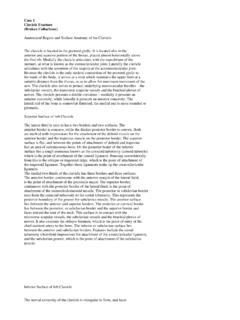Transcription of Outline of the Development of the Irish Housing System
1 CHAPTER 2. Outline of the Development of the Irish Housing System Introduction The Irish Housing System has developed within and through the unique 2 01. pattern of Development of Irish society. This chapter traces the early Irish pastoral settlements, the poor Housing conditions of Irish cities and towns and the creation of the large feudal estates and the poor law System . A. philosophical, political and cultural landmark in Irish Housing law and policy was the British policy of creating a large-scale peasant proprietorship with the redistribution of large landed estates. In a parallel Development , subsequent to the failure of many philanthropic efforts to house the poor, local authorities began to take a proactive role in Housing provision in the early 1900s. Indeed, the Development of Irish public Housing had created a new model of Housing provision the charity rents System , or social Housing , later expanded in Britain as a In Ireland, after Independence, major house-building programmes were 2 02.
2 Undertaken and by 1940 some 41% of Housing stock had been built by the State, benefiting a cross-section of the population. By the 1960s this critical mass of Housing provided a foundation for the promotion by the State of a market in Housing , with supports for mortgage lending, but with minimal regulatory systems. The consequences of the laissez-faire approach led to major price increases in Development land, and the legacies of that time have significantly affected public perceptions of the integrity of Irish politics to the present day. Amongst all this Development the Housing needs of Travellers were only included in Irish Housing policy and legislation in the 1980s. Early Irish Housing Little remains of early Irish Housing , although there are enough records to 2 03. construct some statements concerning its design and use.
3 Early Irish Housing 1. Fraser, M, John Bull's Other Homes. State Housing and British Policy in Ireland, 1883 1922. (Liverpool, Liverpool University Press, 1996), p 60. 13. Chapter 13 3/2/11 12:26:23 PM. Outline OF THE Development OF THE Irish Housing System . corresponded with the settlement patterns of the inhabitants of the The majority lived in circular huts constructed of wood or wickerwork, with the spaces between woven with saplings and twigs and covered with sods, clay or lime. The roof was thatched with straw or Stone was used in construction for the houses of the chieftains and nobility. Houses were often located within a circular settlement or fort, with a ditch to protect them from robbers and wild animals. The clay from the ditch was thrown up on the inside, creating a raised central area, where the house or houses would be built.
4 Some 30 40,000 of these forts, which ranged in size from 40 feet to 300 feet in diameter, can be seen today, and are variously described as lios, rath, dun (for a king), caiseal (where surrounded by stones), etc. Inside the circular houses there was only one room where the family ate, slept and lived, with a fire in the centre. In many of these forts there were underground rooms (known as subterrains) constructed with stones without mortar, and these were used (it is believed) to store food and protect family members during attack. Some people lived on artificial islands in the middle of lakes or in bogs and these forts were known as crannogs. 2 04 A significant archaeological find at Deer Park Farms, Glenarm, Co, Antrim of an early Irish house showed that a typical house was six metres in diameter, with 100 upright stakes creating the basis of the wall with a gap, one metre wide, and flanked by a pair of large post-holes, marking the site of the In the house uncovered in Antrim, dated AD 648, the walls were formed of hazel rods, tightly woven in a complex spiralling pattern around stouter uprights.
5 The space between the walls and of the 2. Evidence now exists of Neolithic circular and rectangular Housing in Ireland dating from 3800 BC, with evidence of ten such houses in ones and twos on the shores of Lough Gur in County Limerick. One of the rectangular houses had internal dimensions of by The external walls were of mud with stone footings and lines of posts stood just inside and outside these footings, and together with internal posts may have supported a roof structure with a covering of thatch. See O'Kelly, MJ, Neolithic Ireland , in Cr in n, D, (ed.). A New History of Ireland (Oxford, OUP, 2005). In the period from 400 AD there is much more evidence of Housing based on ring-forts (often with attached souterrains) and crannogs. See Edwards, N, The archaelogy of early medieval Ireland, c.
6 400-1169: settlement and economy in Cr in n, D (ed.) A New History of Ireland (Oxford, OUP, 2005). Edwards points out, however, that other dwellings also existed for the lower echelons of society who had neither the power or wealth to construct anything so impressive. Aalen describes the approximate 45,000 ring-forts accompanied by their small patches of irregular fields as reflecting a rural economy with decided preference for stock-rearing over tillage. See Aalen, FHA, The Irish rural landscape: synthesis of habitat and history , in Aalen FHA, Whelan, K, & Stout, M, (eds.) Atlas of the Irish Rural Landscape (Cork University Press, 1997). For a detailed examination of the landholding and farming System see Kelly, F, Early Irish Farming, (Dundalgan Press, Dublin Institute for Advanced Studies, 1977).
7 See also Kelly, F, A Guide to Early Irish Law (Dundalgan Press, Dublin Institute for Advanced Studies, 1988). 3. See Joyce, PW, A Smaller Social History of Ancient Ireland (Dublin, Gill & Sons, 1908). 4. I am grateful for the assistance of Professor D ibh Cr in n, Department of History, NUI, Galway, in sourcing this information. 14. Chapter 14 3/2/11 12:26:23 PM. Housing LAW, RIGHTS AND POLICY. hazel rods and the outer wall of stones was packed with a soft organic material, probably a mixture of straw, moss and heather, an early form of cavity walling' .5 Evidence of bedding areas and internal screens was found inside the house. The laws applying in this area before the 12th century (and afterwards) 2 05. in many areas were known as the Brehon laws, after the professional class of trained judges of that name.
8 There is little recorded evidence of the laws (although some exist) as they relied almost entirely on the oral tradition. The society itself was decentralised, with the tuath or local kingdom ruled over by a lord of local king, but under the lordship of some higher king, such as the king of Connacht etc. The society had a hierarchal structure and status was associated with wealth. There were free and unfree classes in the societal The free classes included property owners, higher craftsman and learned scholars. The unfree classes included lower craftsmen, and others without property, including some slaves and those captured in battle. A lower class known as bothach and fuidir were bound to the soil in a particular area after nine generations and could not then move. Of course, larger settlements existed around the early Christian monasteries, which performed the functions of incipient towns, with market, educational and political Kildare, Cashel, Armagh, Glendalough and Kells were significant centres with market-place functions, and by the 11th century had well-defined streets and artisan quarters.
9 Clonmacnoise was a busy metropolis at the meeting of the drumlin tracks between the east and west of the country and between the upper and lower Shannon river routes. The Viking raids from the 9th century onwards established trading centres in Dublin, Wexford, Waterford, Cork and Limerick. The Norman invaders from the 12th century brought their own unique 2 06. style of Housing or castle building, originally using the motte and bailey, created with timber and soil, and later in stone, numbering over 340 castles, mainly in Leinster and the Northeast of the The castle building period extended from the end of the 12th century for 130 years. Later, the walled towns and square four storey stone castles were developed across the country. The Normans also established manorial villages and towns, mainly in the south and east, and of the 270 chartered towns the great majority were in the fertile southeast of the country.
10 Outside the towns, manorial villages following the feudal model were developed. Many stone buildings across the country remain, where the ruling families lived and these castle-like 5. See Hamlin, A, and Lynn, C, Pieces of the Past Archaelogical Excavations by the Department of the Environment, Northern Ireland 1970 1986 (Belfast, HMSO, 1988), p 45. 6. Wiley provides an excellent overview of these issues in Wylie, JCW, Irish Land Law (Dublin, Bloomsbury Professional, 2010), chapter 1. 7. See Whelan, K, Towns and villages , in Aalen FHA, Whelan, K, and Stout, M, (eds.) Atlas of the Irish Rural Landscape (Cork University Press, 1997). 8. See Sweetman, D, The Medieval Castles of Ireland (Dublin, Duchas, 1999), p 17. None have been found in Cork, Kerry or west of the Shannon. 15. Chapter 15 3/2/11 12:26:23 PM.







